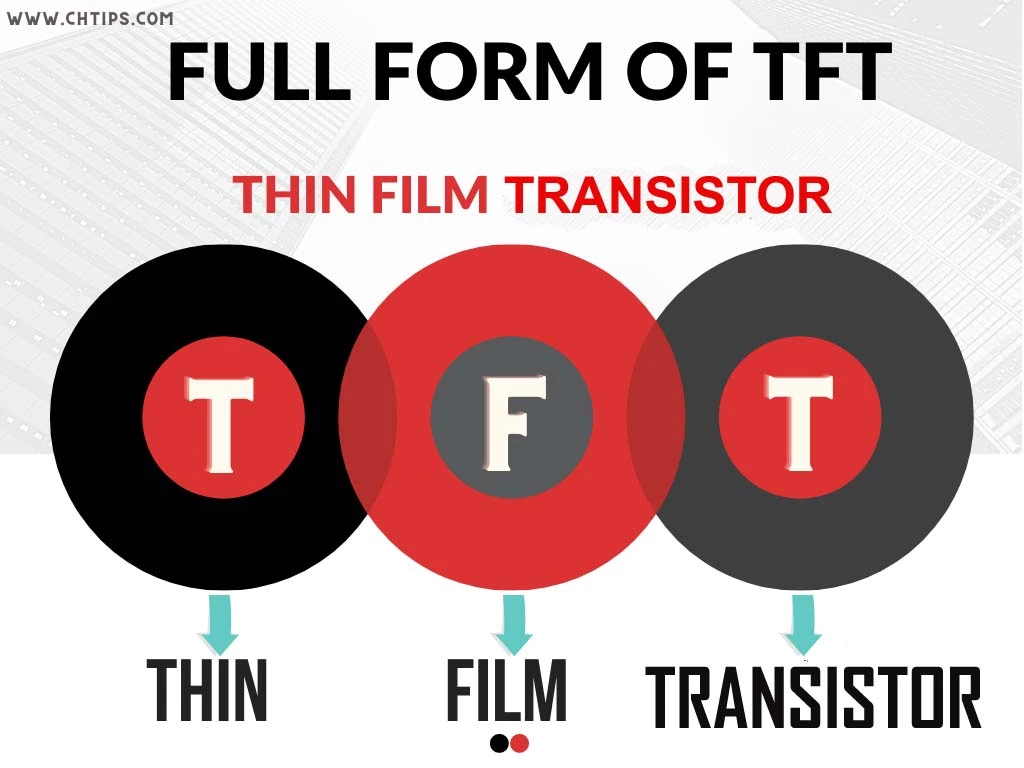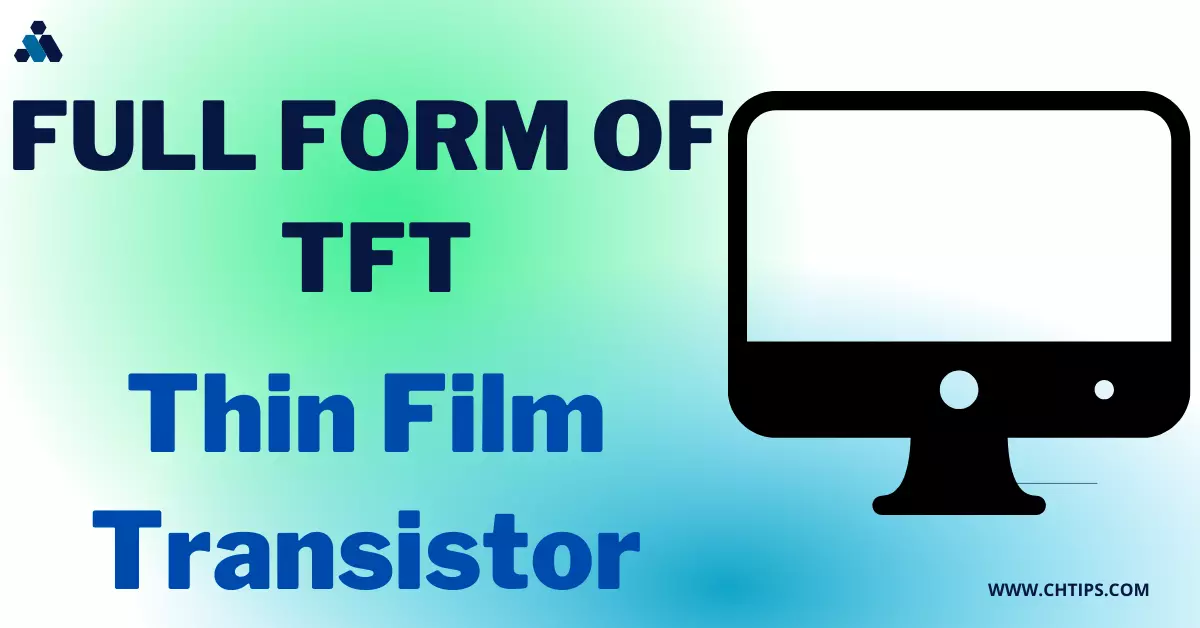TFT is a display screen technology that uses liquid crystal display [LCD]. TFT is developed with the help of silicon-like semiconductor material.
They have small transistors installed in them, therefore, consume less amount of heat and electricity.
The First idea of the TFT Thin Film Transistor was started by Bernard Lechner of RCA Laboratories in the year 1968.
| T | Thin |
| F | Film |
| T | Transistor |
Full Form of TFT in Computer System | TFT Full Form
The Full Form of TFT in Computer System is Thin Film Transistor.
What is TFT in Computer System?
TFT stands for Thin Film Transistor.TFT is one of the best Liquid Crystal Display technologies in terms of image quality and response time. However, it also consumes more power and is more expensive.
For best image quality TFT is used with Liquid Crystal Display they are more expensive and generate more heat and power compared to other display technologies.
Thin-film transistor uses each pixel as its own transistors and helps pixels to have greater contrasts and good quality which can last longer than before.
TFTs are generally used in Smart Phone Technology, Computer Monitors, Laptops, Tablet, Television, Video Games Display, Personal Digital Assistant, Modern Projectors, Visual Display, etc.TFT {Thin Film Transistor} is an old-fashioned technology that has been easily replaced by LCD {Liquid Crystal Display} and LED {Light Emitting Diode}.
The TFT consists of small transistors which consume less power and electricity and produce high-quality images and sound.
The Thin Film Television does not produce a better viewing angle.
TFT monitors are usually designed to work with a specific resolution. They update the screen very fast according to the requirement they can update the screen various times per second.
The majority of the high-resolution and high-performance display electronic devices uses TFT based active matrix to produce excellent quality monitors
Different Types of TFT Monitors
Some of the types of TFT monitors are mentioned below.
- Twisted Nematic (TN)
- Patterned vertical alignment (PVA)
- Advanced superview (ASV)
- Plane line switching (PLS)
- TFT dual-transistor pixel (DTP) or cell technology
- In-plane switching (IPS)
- Advanced fringe field switching (AFFS)
Twisted Nematic [TN]They are the oldest technologies which were considerably low in cost and with poor contrast quality. The Twisted Nematic has poor colour depth and limited viewing angles.
Patterned Vertical Alignment (PVA)They are less expensive compared to other display technologies. Super PVA technology uses 8-bit color depth for better performance and visuals.
Advanced super view (ASV)Advanced Super View {ASV} was designed and developed by the company SHARP. Advanced Super View is also known as Axially Symmetric Vertical Alignment.
Plane line switching (PLS)This technology is designed and developed by Samsung. They are advanced panels which had better viewing angles and excellent image quality.
TFT dual-transistor pixel (DTP) or Cell TechnologyTFT dual transistor pixel or cell technologies are used in electronics, watches, and modern monitors. They are used due to their capability to consume low power and heat.
In-plane switching (IPS)In-plane switching was designed and developed by Hitachi Ltd in the year 1996. They were introduced to overcome the poor viewing angle and poor colour depth.
Advanced fringe field switching (AFFS)Advanced fringe field Switching {AFFS} is an LCD technology and developed in Korea.
This technology offered great performance regarding better viewing angle and color depth and high luminosity.
Where are TFTs Used?
The TFT is used in various devices. Some of them are mentioned below.
- Computer Monitors
- Laptops
- Personal Digital Assistant
- Smart Phones
- Televisions
- Handheld Devices
- Video Games
- Car Dashboards
- Navigation System
- Modern Projectors
Advantages of TFT Monitors
- TFT monitors have higher brightness, contrast levels and are highly energy efficient when compared to other technology.
- They have a higher refresh rate therefore picture quality appears excellent.
- It has a better viewing angle.
- They are quite cheaper than other technology like LED and LCD.
- Their interaction average time is low. Therefore their response time is faster compared to others.
- They look equally good in particularly all resolutions.
- Sharp visibility
- Excellent physical design
Disadvantages of TFT Monitors
- The TFT emits heat and consumes more power compared to others.
- Higher prices when compared to other displays.
- Disappropriate viewing angles.
- They are not recommended for outdoor use.
- They are enabled with glass panelling.
- Unable to produce their own light.
- They need built-in LEDs in their design.
Related Articles
- Full Form of Virus
- Full Form of PDF in Computer
- Full Form of HREF in Computer
- Full Form of HDMI in Computer
- Full Form of PAN in Computer
- Full Form of OMR in Computer
- Full Form of CU in Computer
- Full Form of DSL in Computer
- Full Form of TFT in Computer
- Full Form of FORTRAN in Computer
- Full Form of ALU in Computer
- Full Form of NAS in Computer
- Full Form of SSD in Computer
- Full Form of CRT Monitor in Computer
- Full Form of USB in Computer
- What is the Full Form of GIGO
- What is the Full Form of SCSI
Get In Touch
I have also written and compiled some articles on computers and telecommunications please go through them.
I hope you will like reading it.
I hope that all the questions and queries related to what is the full form of TFT in computer system | TFT Full-Form has been answered here.Please feel free to contact me and if you need to add, remove or update anything from the article please let me know in the comment section or via email.
I will be more than happy to update the article. I am always ready to correct myself.
Share this article with your friends and colleagues this motivates me to write more on the related topics.
!!! Thank You !!!
